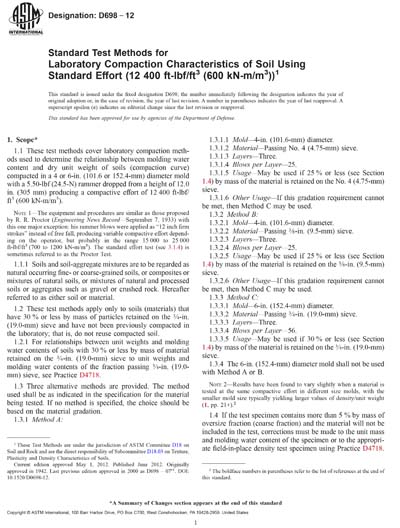Historical
ASTM D698-12
Standard Test Methods for Laboratory Compaction Characteristics of Soil Using Standard Effort (12 400 ft-lbf/ft3 (600 kN-m/m3))
1.1 These test methods cover laboratory compaction methods used to determine the relationship between molding water content and dry unit weight of soils (compaction curve) compacted in a 4 or 6-in. (101.6 or 152.4-mm) diameter mold with a 5.50-lbf (24.5-N) rammer dropped from a height of 12.0 in. (305 mm) producing a compactive effort of 12 400 ft-lbf/ft3 (600 kN-m/m3).
Note 1—The equipment and procedures are similar as those proposed by R. R. Proctor (Engineering News Record
1.1.1 Soils and soil-aggregate mixtures are to be regarded as natural occurring fine- or coarse-grained soils, or composites or mixtures of natural soils, or mixtures of natural and processed soils or aggregates such as gravel or crushed rock. Hereafter referred to as either soil or material.
1.2 These test methods apply only to soils (materials) that have 30 % or less by mass of particles retained on the ¾-in. (19.0-mm) sieve and have not been previously compacted in the laboratory; that is, do not reuse compacted soil.
1.2.1 For relationships between unit weights and molding water contents of soils with 30 % or less by mass of material retained on the ¾ -in. (19.0-mm) sieve to unit weights and molding water contents of the fraction passing ¾ -in. (19.0-mm) sieve, see Practice D4718.
1.3 Three alternative methods are provided. The method used shall be as indicated in the specification for the material being tested. If no method is specified, the choice should be based on the material gradation.
1.3.1 Method A:
1.3.1.1 Mold—4-in. (101.6-mm) diameter.
1.3.1.2 Material—Passing No. 4 (4.75-mm) sieve.
1.3.1.3 Layers—Three.
1.3.1.4 Blows per Layer—25.
1.3.1.5 Usage—May be used if 25 % or less (see Section 1.4 ) by mass of the material is retained on the No. 4 (4.75-mm) sieve.
1.3.1.6 Other Usage—If this gradation requirement cannot be met, then Method C may be used.
1.3.2 Method B:
1.3.2.1 Mold—4-in. (101.6-mm) diameter.
1.3.2.2 Material—Passing 3/8-in. (9.5-mm) sieve.
1.3.2.3 Layers—Three.
1.3.2.4 Blows per Layer—25.
1.3.2.5 Usage—May be used if 25 % or less (see Section 1.4 ) by mass of the material is retained on the 3/8-in. (9.5-mm) sieve.
1.3.2.6 Other Usage—If this gradation requirement cannot be met, then Method C may be used.
1.3.3 Method C:
1.3.3.1 Mold—6-in. (152.4-mm) diameter.
1.3.3.2 Material—Passing ¾-in. (19.0-mm) sieve.
1.3.3.3 Layers—Three.
1.3.3.4 Blows per Layer—56.
1.3.3.5 Usage—May be used if 30 % or less (see Section 1.4 ) by mass of the material is retained on the ¾-in. (19.0-mm) sieve.
1.3.4 The 6-in. (152.4-mm) diameter mold shall not be used with Method A or B.
Note 2—Results have been found to vary slightly when a material is tested at the same compactive effort in different size molds, with the smaller mold size typically yielding larger values of density/unit weight (1, pp. 21+).
1.4 If the test specimen contains more than 5 % by mass of oversize fraction (coarse fraction) and the material will not be included in the test, corrections must be made to the unit mass and molding water content of the specimen or to the appropriate field-in-place density test specimen using Practice D4718.
1.5 This test method will generally produce a well-defined maximum dry unit weight for non-free draining soils. If this test method is used for free-draining soils the maximum unit weight may not be well defined, and can be less than obtained using Test Methods D4253.
1.6 All observed and calculated values shall conform to the guidelines for significant digits and rounding established in Practice D6026, unless superseded by this standard.
1.6.1 For purposes of comparing measured or calculated value(s) with specified limits, the measured or calculated value(s) shall be rounded to the nearest decimal or significant digits in the specified limits.
1.6.2 The procedures used to specify how data are collected/recorded or calculated, in this standard are regarded as the industry standard. In addition, they are representative of the significant digits that generally should be retained. The procedures used do not consider material variation, purpose for obtaining the data, special purpose studies, or any considerations for the user’s objectives; and it is common practice to increase or reduce significant digits of reported data to be commensurate with these considerations. It is beyond the scope of this standard to consider significant digits used in analytical methods for engineering design.
1.7 The values stated in inch-pound units are to be regarded as standard. The values given in parentheses are mathematical conversions to SI units that are provided for information only and are not considered standard, except for units of mass. The units for mass are given in SI units only, g or kg.
1.7.1 It is common practice in the engineering profession to concurrently use pounds to represent both a unit of mass (lbm) and a force (lbf). This implicitly combines two separate systems of units; that is, the absolute system and the gravitational system. It is scientifically undesirable to combine the use of two separate sets of inch-pound units within a single standard. This standard has been written using the gravitational system of units when dealing with the inch-pound system. In this system, the pound (lbf) represents a unit of force (weight). However, the use of balances or scales recording pounds of mass (lbm) or the recording of density in lbm/ft3 shall not be regarded as a nonconformance with this standard.
1.8 This standard does not purport to address all of the safety concerns, if any, associated with its use. It is the responsibility of the user of this standard to establish appropriate safety and health practices and determine the applicability of regulatory limitations prior to use.
1.9 Warning
ASTM International [astm]

